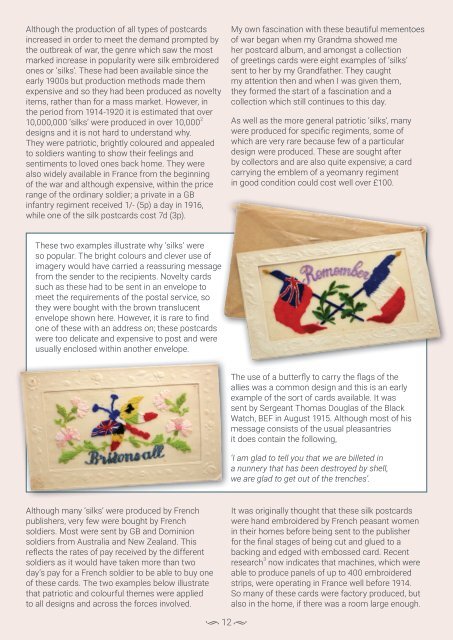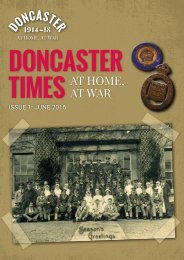Doncaster Times Issue 2 - November 2016
Doncaster Times is a biannual publication of articles and pieces researched and written by members of the public, volunteers and professionals. For its first four years, the magazine will feature articles about Doncaster during the First World War, to commemorate the centenary. The most recent publication is available in hard copy only, available to purchase from Doncaster Museum and Art Gallery, Doncaster Central Library and the Tourist Information Centre.
Doncaster Times is a biannual publication of articles and pieces researched and written by members of the public, volunteers and professionals. For its first four years, the magazine will feature articles about Doncaster during the First World War, to commemorate the centenary. The most recent publication is available in hard copy only, available to purchase from Doncaster Museum and Art Gallery, Doncaster Central Library and the Tourist Information Centre.
You also want an ePaper? Increase the reach of your titles
YUMPU automatically turns print PDFs into web optimized ePapers that Google loves.
Although the production of all types of postcards<br />
increased in order to meet the demand prompted by<br />
the outbreak of war, the genre which saw the most<br />
marked increase in popularity were silk embroidered<br />
ones or ‘silks’. These had been available since the<br />
early 1900s but production methods made them<br />
expensive and so they had been produced as novelty<br />
items, rather than for a mass market. However, in<br />
the period from 1914-1920 it is estimated that over<br />
10,000,000 ‘silks’ were produced in over 10,000 2<br />
designs and it is not hard to understand why.<br />
They were patriotic, brightly coloured and appealed<br />
to soldiers wanting to show their feelings and<br />
sentiments to loved ones back home. They were<br />
also widely available in France from the beginning<br />
of the war and although expensive, within the price<br />
range of the ordinary soldier; a private in a GB<br />
infantry regiment received 1/- (5p) a day in 1916,<br />
while one of the silk postcards cost 7d (3p).<br />
My own fascination with these beautiful mementoes<br />
of war began when my Grandma showed me<br />
her postcard album, and amongst a collection<br />
of greetings cards were eight examples of ‘silks’<br />
sent to her by my Grandfather. They caught<br />
my attention then and when I was given them,<br />
they formed the start of a fascination and a<br />
collection which still continues to this day.<br />
As well as the more general patriotic ‘silks’, many<br />
were produced for specific regiments, some of<br />
which are very rare because few of a particular<br />
design were produced. These are sought after<br />
by collectors and are also quite expensive; a card<br />
carrying the emblem of a yeomanry regiment<br />
in good condition could cost well over £100.<br />
These two examples illustrate why ‘silks’ were<br />
so popular. The bright colours and clever use of<br />
imagery would have carried a reassuring message<br />
from the sender to the recipients. Novelty cards<br />
such as these had to be sent in an envelope to<br />
meet the requirements of the postal service, so<br />
they were bought with the brown translucent<br />
envelope shown here. However, it is rare to find<br />
one of these with an address on; these postcards<br />
were too delicate and expensive to post and were<br />
usually enclosed within another envelope.<br />
The use of a butterfly to carry the flags of the<br />
allies was a common design and this is an early<br />
example of the sort of cards available. It was<br />
sent by Sergeant Thomas Douglas of the Black<br />
Watch, BEF in August 1915. Although most of his<br />
message consists of the usual pleasantries<br />
it does contain the following,<br />
‘I am glad to tell you that we are billeted in<br />
a nunnery that has been destroyed by shell,<br />
we are glad to get out of the trenches’.<br />
Although many ‘silks’ were produced by French<br />
publishers, very few were bought by French<br />
soldiers. Most were sent by GB and Dominion<br />
soldiers from Australia and New Zealand. This<br />
reflects the rates of pay received by the different<br />
soldiers as it would have taken more than two<br />
day’s pay for a French soldier to be able to buy one<br />
of these cards. The two examples below illustrate<br />
that patriotic and colourful themes were applied<br />
to all designs and across the forces involved.<br />
It was originally thought that these silk postcards<br />
were hand embroidered by French peasant women<br />
in their homes before being sent to the publisher<br />
for the final stages of being cut and glued to a<br />
backing and edged with embossed card. Recent<br />
research 3 now indicates that machines, which were<br />
able to produce panels of up to 400 embroidered<br />
strips, were operating in France well before 1914.<br />
So many of these cards were factory produced, but<br />
also in the home, if there was a room large enough.<br />
•<br />
12 •




